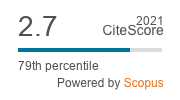Lotka-Volterra System of Predator-Prey Type with Time-Dependent Diffusive
Abstract
The dynamics of a Lotka-Volterra system of predator-prey type with time-dependent diffusive is studied. First, the existence and uniquely of positively global solution, uniform boundedness, and extinction are investigated. The analytical investigation uses a C0-quasi semigroup approach. The stabilities of the positively homogeneous steady states of the system are analyzed. Further, a simple analysis of Turing instability and Hopf bifurcation due to diffusion is also discussed that is confirmed by the bifurcation diagram.
References
S.J. Lee, H.K. Lee and H.S. Oh, Technological forecasting at the Korean stock market: a dynamic competition analysis using Lotka-Volterra model, Technol. Forecast. Soc. Change, 72(2005), 1044–1057.
C.A. Comes. Banking system: Three level Lotka-Volterra model. Procedia Econ. Financ. 3(2012), 251-255.
H.C. Hung, Y.C. Chiu, H.C. Huang and M.C. -Wu, An enhanced application of LotkaVolterra model to forecast the sales of two competing retail formats, Comput. Ind. Eng., 109(2017), 325–334.
O. Nikolaieva and Y. Bochko, Application of the "predator-prey" model for analysis and forecasting the share of the market of mobile operating systems, Int. J. Innov. Technol. Econ., 4(24) (2019), 3-11.
T.K. Kar, Stability analysis of a prey-predator model incorporating a prey refuge, Commun. Nonlinear Sci. Numer. Simul., 10(2005), 681-691.
A.W. Wijeratne, F. Yi and J. Wei, Bifurcation analysis in the diffusive Lotka-Volterra system: An application to market economy, Chaos Solit. Fractals., 40(2009), 902-911.
F. Yi, J. Wei and J. Shi, Bifurcation and spatiotemporal patterns in a homogeneous diffusive predator-prey system, J. Differ. Equ., 246(2009), 1944-1977.
S. Yan and S. Guo, Dynamics of a Lotka-Volterra competition-diffusion model with stage structure and spatial heterogeneity, Discrete Contin. Dyn. Syst.-B, 23(4)(2018), 1559-1579.
H.C. Hung, Y.C. Chiu, H.C. Huang and M.C. Wu, An enhanced application of LotkaVolterra model to forecast the sales of two competing retail formats, Comput. Ind. Eng., 109(2017), 325-334.
P. Zhou and D. Xiao, Global dynamics of a classical Lotka-Volterra competitiondiffusion-advection system, J. Funct. Anal., 275(2)(2018), 356-380.
Y. Li and Y. Zhou, Turing–Hopf bifurcation in a general Selkov–Schnakenberg reaction–diffusion system, Chaos Solit. Fractals., 171(2023), 1-10.
F. Souna, A. Lakmechea and S. Djilali, Spatiotemporal patterns in a diffusive predator-prey model with protection zone and predator harvesting, Chaos Solit. Fractals., 140(2020), 1-13.
S. Yan, D. Jia, T. Zhang and S. Yuan, Pattern dynamics in a diffusive predator-prey model with hunting cooperations, Chaos Solit. Fractals., 130(2020), 1-12.
A. Sirohi, M. Banerjee and A. Chakraborti, Spatiotemporal pattern formation in a prey-predator model under environmental driving forces, Journal of Physics: Conference Series 638(2015) 012004.
M. Banerjee and S. Banerjee, Turing instabilities and spatio-temporal chaos in ratio-dependent Holling–Tanner model, Math. Biosci., 236(2012), 64-76.
X.P. Yan and C.H. Zhang, Stability and turing instability in a diffusive predator-prey system with Beddington-DeAngelis functional response, Nonlinear Anal. Real World Appl., 20(2014), 1-13.
Z. Zhao and H.A. Hu, Bundedness, stability and pattern formation for a predatorprey model with sigmoid functional response and prey-taxis, Electron. J. Differ. Equ., 2023(37)(2023), 1–20.
M. Kirane, S. Badraoui and M. Guedda, Uniform boundedness and extinction results of solutions to a predator-prey system, Electron. J. Qual. Theory Differ. Equ., 11(2020), 1-11.
P. Hess, Periodic-Parabolic Boundary Valus Problems and Positivity, Longman Scientific & Techincal, Harlow, 2003.
S. Sutrima, M. Mardiyana, R. Setiyowati and R. Respatiwulan, A new approach on the well-posedness of nonautonomous Cauhy problems: An application in population growth, J. Nonlinear Funct. Anal., 2021(2021), Article ID 29.
S. Sutrima, C.R. Indrati and L. Aryati, Contraction quasi semigroups and their applications in decomposing Hilbert spaces, Azerbaijan J. Math., 10(1)(2020), 57-74.
S. Sutrima, C.R. Indrati and L. Aryati, Controllability and observability of nonautonomous Riesz-spectral systems, Abstr. Appl. Anal., 4210135(2018), 1-17.
S. Sutrima, C.R. Indrati and L. Aryati, Exact null controllability, stabilizability, and detectability of linear nonautonomous control systems: Quasisemigroup approach, Abstr. Appl. Anal., 3791609(2018), 1-12.
S. Sutrima, M. Mardiyana, Respatiwulan, W. Sulandari and M. Yunianto, Approximate controllability of nonautonomous mixed boundary control systems, AIP Conference Proceedings 2326(020037)(2021), 1-9.
S. Sutrima, C.R. Indrati and L. Aryati, Strongly continuous quasi semigroups in optimal control problems for non-autonomous systems, Asian-Eur. J. Math., (2021) https://doi. org/10.1142/ S1793557121501230.
C.V. Pao, Nonlinear Parabolic and Elliptic Equations, Plenum Press, New York, 1992.
Downloads
Published
How to Cite
Issue
Section
License
Copyright (c) 2024 Results in Nonlinear Analysis

This work is licensed under a Creative Commons Attribution 4.0 International License.



